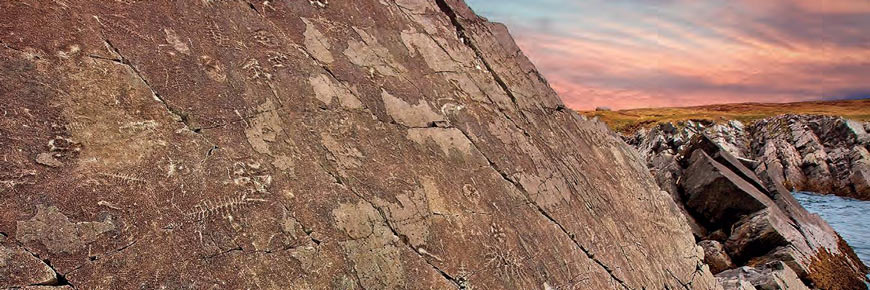
The fossiliferous E surface in the Mistaken Point Formation at Watern Cove
© Newfoundland and Labrador Tourism/Barrett and MacKay Photography
Mistaken Point
Newfoundland and Labrador
Date of Inscription: 2016
Mistaken Point is a globally significant fossil site on the southeastern tip of the island of Newfoundland. The World Heritage site is almost entirely located within Mistaken Point Ecological Reserve, where more than 10,000 fossil impressions, ranging from a few centimetres to nearly 2 metres in length, are readily accessible for scientific study and supervised viewing by visitors to the scenic, rugged Atlantic coastline.
Justification of outstanding universal value
Criterion (viii): Mistaken Point fossils constitute an outstanding record of a critical milestone in the history of life on Earth, “when life got big” after almost three billion years of microbe-dominated evolution. The fossils range in age from 580 to 560 million years, the longest continuous record of Ediacara-type megafossils anywhere, and predate the Cambrian explosion (the oldest fossil evidence of ancestors of most modern animal groups) by more than 40 million years. Mistaken Point contains the world’s oldest-known examples of large (up to 2 metres long), architecturally complex organisms, including soft-bodied, ancestral animals. Ecologically, Mistaken Point contains the oldest and most diverse examples of Ediacaran deep-sea communities in the world and the earliest documented examples of ecological tiering and secondary community succession. Other attributes contributing to the property’s Outstanding Universal Value include the world’s first examples of metazoan locomotion, exceptional potential for radiometric dating of the assemblages, and evidence for the role of ancient oxygen levels in the regional and global appearance of complex multicellular life.
Full description
The fossils at Mistaken Point illustrate a critical time in the history of life: the first appearance of large, biologically complex organisms, including the first ancestral animals. These soft-bodied creatures lived during the middle Ediacaran Period (580 to 560 million years ago) and inhabited the deep sea floor of an ancient ocean where they were buried and preserved in exceptional detail by influxes of volcanic ash. The animals died where they lived, and after being hidden for hundreds of millions of years, were gradually exposed by the forces of modern erosion revealing more than 100 fossil sea-floor surfaces, ranging from small beds with single fossils to tennis-court-sized surfaces adorned with up to 4,500 megafossils.
The exquisitely preserved fossils at Mistaken Point make up the most abundant and diverse assemblage of large Ediacaran fossils of deep marine origin known anywhere in the world and provide a detailed chronology for 20 million years in the early evolution of complex life.
Related links
- Anticosti, Quebec
- Tr’ondëk-Klondike, Yukon
- Writing-on-Stone / Áísínai’pi
- L’Anse aux Meadows National Historic Site
- Nahanni National Park Reserve
- Dinosaur Provincial Park
- Kluane / Wrangell-St.Elias / Glacier Bay /...
- Head-Smashed-In Buffalo Jump
- SG̱ang Gwaay
- Wood Buffalo National Park
- Canadian Rocky Mountain Parks
- Historic District of Old Québec
- Gros Morne National Park
- Old Town Lunenburg
- Waterton-Glacier International Peace Park
- Miguasha National Park
- Rideau Canal
- Joggins Fossil Cliffs
- Landscape of Grand Pré
- Red Bay Basque Whaling Station
- Pimachiowin Aki
- Date modified :